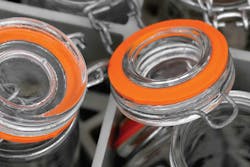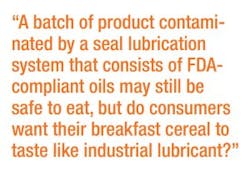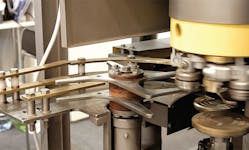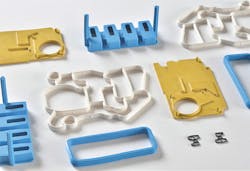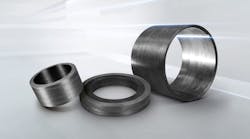Sealing in the food industry can be extremely challenging in many ways. Typically, food sealing solutions experts are not faced with the high pressures of the oil and gas industry, or the high temperatures of steel working or power generation. Valves, pumps and pipelines come into play as in many other industrial sectors, but nevertheless unique operating conditions and industry regulations ensure that sealing in the food industry continues to keep experts on their toes.
One key challenge is hygiene. How do we help our customers ensure that the product they produce is fit for consumption? The design, supply, installation and maintenance of hygienic sanitary seals involve many elements.
Materials
First, consider the materials. Many standards and regulatory guidelines help ensure that the seal material is safe to use in food production machinery.
In the U.K., food and beverage processors are primarily concerned with the European regulations laid out in EC1935/2004 and EC2023/2006 in relation to “Materials and articles intended to come into contact with food,” including “Good Manufacturing Practice.” The principle of the directive is that materials should be sufficiently inert to prevent transfer of substances into food in quantities that might be large enough to endanger human health.
In addition, the U.S. Food and Drug Administration (FDA) is the U.S. federal agency responsible for ensuring that foods are safe, wholesome and sanitary; human and veterinary drugs, biological products and medical devices are safe and effective; and cosmetics are safe.
The FDA’s CFR21.177.2600 describes the relevant regulations for “Rubber articles intended for repeated use.” Paragraphs A to D detail the requirements for dry foods, with paragraphs E and F detailing requirements for aqueous and fatty foods. CFR21.177.1550 relates to “perfluorocarbon resins” such as polytetrafluoroethylene (PTFE).
While the FDA has no jurisdiction outside the U.S., the guidelines outlined in CFR21.177.2600 and CFR21.177.1550 are widely used throughout the food industry worldwide.
Similarly, 3-A Sanitary Standards Inc.’s 18-03 standard is widely adopted by many countries outside the U.S. This standard defines specifications and best practices for the design, manufacture, installation and use of hygienic equipment. “3-A Sanitary Standard 18-03 for multiple-use rubber and rubber-like materials used in product contact surfaces in dairy equipment” describes requirements for food quality materials that are suitable for steam sterilization, acid and alkali cleaning solutions and chlorine sanitizing agents.
One of the most important commodities in food production is water, which is used throughout all areas of preparation, production and cleaning. It is vitally important that all the seals that come into contact with water are manufactured from materials that will not contaminate the water in any way. In the U.K., the Water Regulations Advisory Scheme (WRAS) ensures that materials approved for drinking water applications must satisfy the requirement of BS 6920. The testing regime for WRAS approval is different than for FDA testing, in that it tests the “Suitability of non-metallic products for use in contact with water intended for human consumption with regard to their effect on the quality of the water.” The test ensures sealing materials do not promote the propagation of bacteria or affect the color, appearance and taste of drinking water.
The above regulations are aimed at ensuring the sealing materials do not leach, bleed or otherwise secrete harmful or undesirable contaminants into the foodstuff being produced. However, a significant requirement exists to ensure that sealing products themselves are free of some particular constituents. Animal-derived ingredients (ADI) are considered undesirable in many areas of food production. Sealing materials free from ADI avoids the potential risk of bovine spongiform encephalopathy (mad cow disease) and transmissible spongiform encephalopathy contamination with respect to source, manufacture and treatment in products intended for human consumption.
Performance
Aside from regulatory compliance, one point is often overlooked – sealing performance. It is not uncommon for a seal specification to state that it must comply with FDA, WRAS and EC1935/2004, and also be ADI-free. However, as obvious as this might seem, a seal that complies with regulation is not necessarily a seal fit for purpose.
A batch of product contaminated by a seal lubrication system that consists of FDA-compliant oils may still be safe to eat, but do consumers want their breakfast cereal to taste of industrial lubricant?
A rubber seal may meet all the criteria of EC1935/2004. It will not harm humans if it ends up in their yogurt, but would they choose to eat it?
It is clear that no one would choose to eat contaminated food even if it were known that the contaminants were harmless. To mitigate this risk, proper consideration must be given to the correct selection of seal and material for the application. A commonly used acronym, STAMPS, will assist the food producer and the seal supplier to truly understand the application and enable an informed recommendation: Size, Temperature, Application, Media, Pressure, Speed.
The more information that can be provided on the following factors, the better the resultant sealing performance.
- Size: Detailed drawings of the seal area and surrounding interfaces
- Temperature: Including minimum, maximum, typically running, thermal cycling
- Application: Type of movement, type of equipment being sealed, make and model of equipment, surface finish, why seals are being changed, how did they fail, why did they fail, request failed seal, request site visit
- Media: What does the seal come into contact with – not forgetting wash-down, clean-in-place (CIP) and sterilize-in-place (SIP) cycles
- Pressure: Including minimum, maximum, typically running, pressure cycling
- Speed: Surface contact speed, shaft diameter, shaft speed (rpm)
With accurate STAMPS information it is possible to make an informed recommendation regarding the correct seal for the application. Unlike most other industries, many of the application conditions in the food industry are relatively low-pressure, low-temperature, and media are often nonaggressive in nature. However, one cautionary note on this point is that the cleaning regime in place is often more challenging from a sealing perspective than the actual production process itself. The introduction of caustic media for cleaning, along with steam and pressures above those of normal running parameters, can cause damage to seals, so it is vitally important that all this information is considered.
In the case of many elastomeric and polymeric sealing components, the use of steam can cause the seal to deteriorate and ultimately result in mechanical failure. Many grades of steam-resistant sealing materials are available, but unless the CIP and SIP parameters are known, the risk of seal failure increases.
ClP, SIP & EHEDG
CIP and SIP are now commonplace in the food industry – not only to ensure cleanliness and prevent product cross-contamination between different product runs, but also to ensure that hard-to-reach places are cleaned and do not form bug traps or allow product buildup. As outlined above, material selection is vitally important to ensure that CIP and SIP processes do not cause damage to the seals and sealing elements.
Taking this a stage further, seals are available that enable and accommodate the use of SIP and CIP. The inclusion of inlet and outlet ports (drains) facilitate the precise cleaning of seal cavities, with the placement of the ports ensuring efficient and effective draining and drying. In addition, features such as seal inspection ports enable seal condition monitoring to ensure the seal is performing correctly and that no product egress or contaminant ingress exists. Consideration of the orientation of features such as O-ring grooves ensures they cannot hold standing water, subsequently reducing the risk of bacteria growth in the system.
Many other design features and practices are now commonplace in the food industry. While no governing bodies oversee and regulate hygienic design and hygienic practices per se, there is the European Hygienic Engineering & Design Group (EHEDG).
The EHEDG was founded in 1989 as a nonprofit consortium comprised of manufacturers, producers, suppliers, government bodies, research institutes and public health authorities. The idea of this consortium was to promote food safety through wholesale improvements in hygienic engineering and design. The EHEDG is a supporter of European legislation, requiring that all food handling, preparation, processing and packaging is done hygienically and in accordance with the directives for food hygiene, machinery and food contact materials. For more on hygiene requirements for machinery design, refer to EC Directive 2006/42/EC, EN 1672-2 and EN ISO 14159.
Users and manufacturers of food process equipment are responsible for implementation of these EHEDG requirements to comply with national and international legislature.
Detection & contamination
On rare occasions, mainstream media cover product recalls caused by contamination. This might involve glass, plastic, rubber or some other foreign object. However, for any regular subscriber to food sector trade publications, online periodicals or forums, stories of contaminant-based recalls are covered on an almost daily basis. Most engineering and manufacturing professionals would favor contamination prevention rather than detection. Nevertheless, regardless of the robustness of processes implemented across the supply chain, it is inevitable that product contamination will occur at some point – as much as the industry might hate to admit it. So, when contamination does occur, how are potential risks to customers mitigated?
Many technological advances have occurred in recent years and commercially available detection equipment is widely available. Visual systems detect foreign objects by shape or color. Other methods commonly used include metal detection, X-ray and ultrasound. Some of these methods can be accommodated by seal manufacturers, with metal-detectable variants of rubbers, plastics and specific colored seals that contrast with the food product, and which can be detected by visual systems.
Production & traceability
If a seal’s origin is unknown, how is its safety for use in food production ensured?
Take for instance a 100 percent virgin PTFE Tri-clamp gasket. Viewed at face value, from an FDA perspective (CFR21.177.1550) the gasket is FDA-compliant because 100 percent virgin PTFE is listed as a compliant polymer within the CFR21.177.1550.
However, this does not guarantee that the product is safe for use; Rather, the generic material from which the gasket is manufactured is generally recognized as safe.
For example, perfectly good-quality, FDA-compliant identical material could be supplied to two manufacturers. One may have a state-of-the-art computer numerical control machining facility in an ISO Class 8 cleanroom environment. The other could be a hobbyist in a backyard workshop with a 50-year-old manual lathe, motor oil on the bench, plant food on the shelf and spider webs overhead.
Both manufacturers are capable of producing seals to the correct geometry. Both manufacturers have access to a computer and can produce a Certificate of Conformity stating that the goods are made from 100 percent FDA-compliant materials. But the risk of contamination in the former is much less than that of the latter.
When purchasing seals from a local workshop or when buying from a faceless website, additional care and caution is advised when procuring seals for the food industry.
Installation
When a seal leaks or fails, it is all too easy to blame the seal or the seal supplier. You have measured your mixer and supplied drawings. You have stated you need FDA-compliant seals, given details of the SIP process, stated the minimum, maximum and running pressures, speeds and temperatures. Assuming that you now have the right seal for the task in hand, let us also assume the mixer is brand-new and the shaft perfectly balanced – regardless of the media or stage of the mixing cycle. So why does the seal still leak?
In many cases this relates back to the installation. Even the simplest of seals will leak if installed incorrectly. Some companies specialize in nothing but assembling flanged connections because if done incorrectly, even a bolted flanged connection will leak. In the instance of flanged connections, EN1591-4 sets out a framework for proper installation, training and competence of flange technicians. The aim is to ensure that anyone tasked with installing gaskets between flanges understands the correct procedure and can prove that they are competent to carry out the task.
In the case of other seal types – such as braided packing, lip seals and mechanical seals – no such framework exists, so maintenance professionals are reliant on manufacturers’ installation guides or skills learned in the workshop. As many seals are of a proprietary design, input from the manufacturer or appointed approved distribution partner is vital. To assume that two mechanical seals from two different manufacturers can be installed in the same way can lead to costly errors and issues. Seal damage and subsequent seal replacement is not only annoying, but it can also have a significant financial cost when considering replacement parts, labor and downtime. When a seal fails to perform the task it was designed to do, allowing the ingress of contaminants or cross-contamination between batches, harm is caused to reputations as well as consumers.
In certain applications in the food industry, especially where airborne powder products with high calorific values are involved, the risk of explosion is elevated. Similarly, where hot cooking oils or high-strength alcohols are present, the risk of fire is a key concern. For several different reasons, correct seal installation is critically important.
Summary
To summarize, sealing in the food industry is not simply a matter of regulatory compliance. A unique set of requirements of a regulatory and technical nature must be addressed. Foremost must be safety. Ultimately, any shortcuts taken when selecting sealing products and seal suppliers potentially put at risk the consumer and food production operatives. Ensuring that products are traceable, compliant and used in the correct manner can significantly reduce risk. It all helps to ensure the safety and longevity of products and food production alike.
Russ Pimblett is the business development manager at FTL Technology. He specializes in sealing solutions for food process equipment, using extensive mechanical engineering experience to find innovative solutions for varied industrial problems. Pimblett may be reached at 01132 521061.
